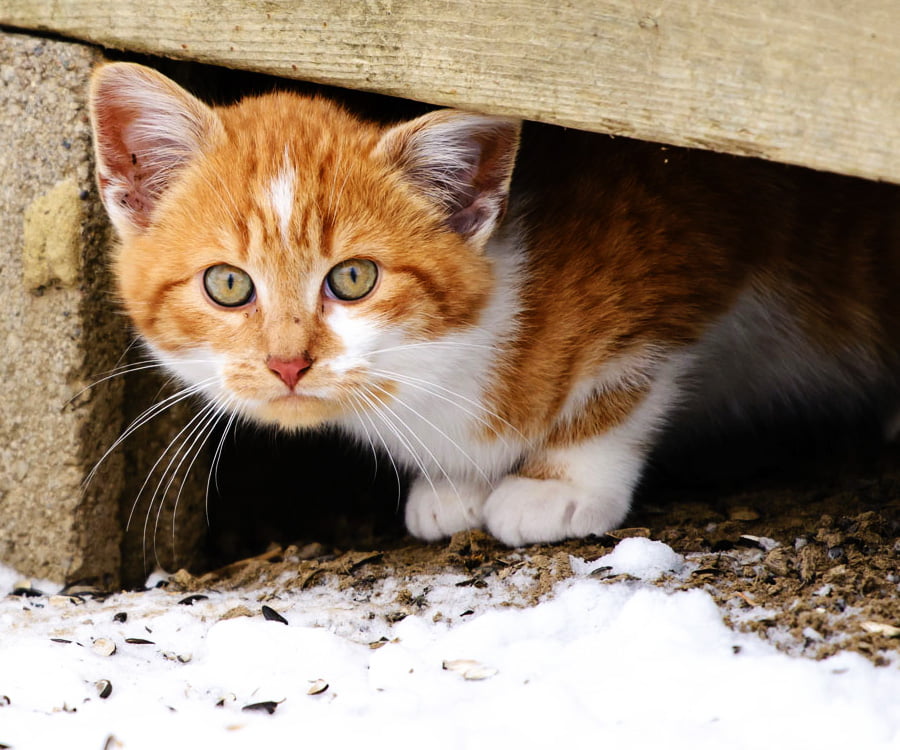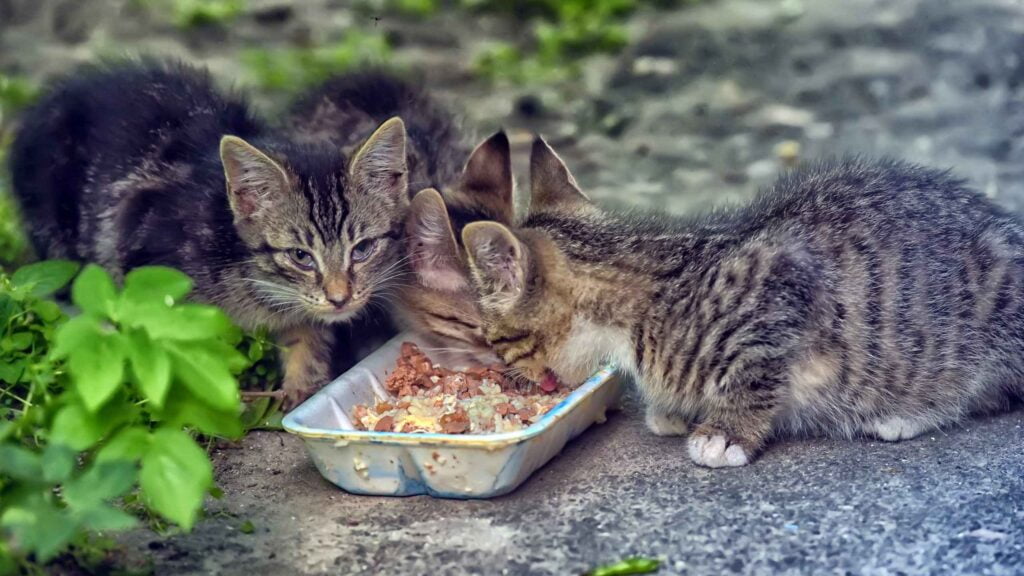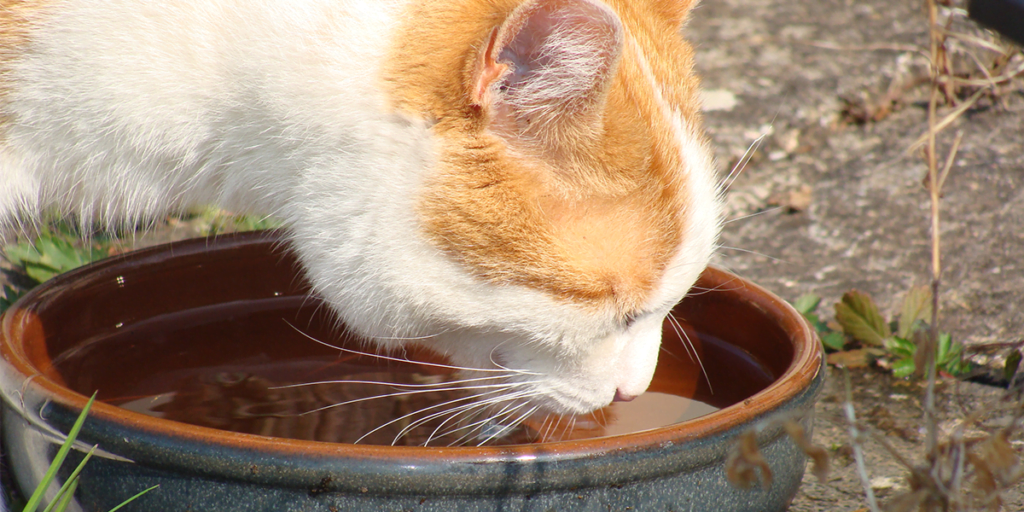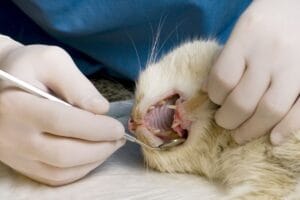The Ultimate Guide to Feeding Feral Cats

Feeding feral cats can be a challenging and rewarding experience for those who are passionate about animal welfare. Feral cats are domestic cats that have returned to their wild state, often due to abandonment or lack of socialization. Feral kittens are born in the wild, and their survival depends on their ability to find food and shelter. However, with the right knowledge and resources, we can help these vulnerable kittens thrive and grow into healthy adult cats.
One of the main challenges of feeding feral cats is ensuring that they receive proper nutrition. Kittens have specific dietary requirements that are different from adult cats, and it’s important to provide them with the necessary nutrients to support their growth and development. Additionally, feral cats may have weakened immune systems or health issues due to their exposure to the elements and lack of veterinary care. As a result, it’s crucial to provide them with the best possible nutrition to help prevent illnesses and support their overall health.
In this ultimate guide to feeding feral cats, we will discuss the essential components of a Cat’s diet, including the types of food and nutrients they require. We will also provide tips and strategies for feeding feral cats safely and effectively, as well as ways to address common feeding challenges. With this guide, you’ll have the tools and knowledge needed to provide the best possible care for feral cat kittens in your community.
Understanding Feral Cats
Feral cats, also known as community cats, are domestic cats that have adapted to living in the wild. They are often the result of abandonment or have been born into a feral colony. Unlike stray cats, feral cats have not been socialized with humans and tend to avoid human interaction. They live in colonies and rely on each other for survival. Feral cats face many challenges in their daily lives, including finding food and water, shelter, and avoiding predators. These cats can be found in both urban and rural areas, and their population is estimated to be in the millions.
Understanding the diet and eating habits of feral cats is essential for their survival. Feral cats require a varied and balanced diet that provides essential nutrients like protein, fat, carbohydrates, vitamins, and minerals. They also require fresh water, which can be difficult to find in the wild. Feral cats tend to eat small meals throughout the day and night, and their feeding habits can vary depending on the availability of food.
The Nutritional Needs of Feral Cats

Feral cats have unique nutritional needs that must be met to ensure their survival and health. As they live in the wild, they rely on their hunting skills to obtain their daily diet, which consists of protein-rich meat. However, it’s not always easy for them to catch enough prey, especially in urban areas where food sources are scarce. Therefore, it’s important for caretakers of feral cats to provide a balanced and nutritious diet that meets their dietary requirements.
A balanced diet for feral cats should contain essential nutrients like protein, fat, carbohydrates, vitamins, and minerals. Kitten food is the best option for feral cats, as it contains a higher percentage of protein and fat than adult cat food, which is essential for their growth and development. Wet or canned kitten food is preferred over dry food as it provides the necessary moisture that helps keep them hydrated.
Feeding Feral Cats
Feeding feral cats can be a challenging and rewarding experience. As caretakers, it is essential to provide the necessary nutrients and care for these cats to help them grow and thrive. Here is a how you can feed feral cats:
- Assess the needs of the cats: Before beginning to feed feral cats, it’s important to assess their needs. Check the area to see how many cats are present, their age, and general health. This will help in determining the amount of food needed.
- Determine the feeding location: The feeding location should be safe and secure, away from predators and other cats. Consider placing the food in a sheltered area or using a feeding station.
- Choose the right food: Feral cats require a balanced diet that provides essential nutrients like protein, fat, carbohydrates, vitamins, and minerals. Wet or canned cat food is the best option, as it contains the necessary nutrients that help them stay healthy.
- Establish a feeding schedule: Feeding feral cats on a regular schedule helps them establish a routine and ensures they are receiving enough nutrition. It’s recommended to feed cats at the same time every day.
- Introduce food gradually: It’s important to introduce new food gradually to prevent digestive upset. Start by mixing a small amount of the new food with their current food and gradually increase the amount over a week or two.
- Provide clean water: Access to clean and fresh water is essential for feral cats’ health. Use a shallow dish to make it easy for them to drink, and change the water frequently.
- Monitor the cats: Regularly monitor the cats’ health and behavior to ensure they are receiving enough food and water. Observe for any signs of illness or injury.
Providing Clean Water and Emergency Feeding Options for Feral Cats

Access to clean and fresh water is just as important as providing nutritious food for feral cats. In addition to their daily meals, feral cats require a consistent supply of fresh water to remain healthy and hydrated. It’s essential to ensure that the water source is always clean and free of contaminants, as dirty water can lead to illness and dehydration.
To provide clean water for feral cats, use a shallow dish that is easy for them to drink from, and change the water frequently to prevent it from becoming stagnant. During the colder months, make sure the water source is not frozen and use a heated water bowl or add hot water to the dish.
In cases where you may not have access to cat food or need to supplement their diet, there are a few emergency feeding options available. Canned tuna or chicken, boiled eggs, and even baby food can be given to feral cats in small amounts. However, it’s important to note that these options should not replace a balanced diet and should only be used in situations where there is no other option available.
By providing clean water and emergency feeding options, you can help ensure the health and well-being of feral cats in your area. Remember to always handle food and water dishes with gloves and practice good hygiene to prevent the spread of disease.
Addressing Common Feeding Issues
Feeding feral cats can be a challenging task, and sometimes unexpected issues may arise. Here are some common feeding issues for feral cats and how to address them:
- Food Aggression
Food aggression is a common issue among feral cats, particularly in colonies where resources are limited. It can be dangerous to intervene in these situations, as cats may become aggressive towards humans or other cats. One way to address food aggression is to provide multiple feeding stations and ensure each station has enough food for all cats in the colony. This can reduce competition and prevent aggressive behavior.
- Feeding in Cold Weather
During cold weather, feral cats require extra calories to maintain their body temperature. It’s important to provide them with extra food and to feed them in a sheltered area where they can stay warm. You can also provide blankets or straw for insulation.
- Feeding During Kitten Season
Kitten season, typically from late spring to early fall, can be a challenging time for feral cat caregivers. The population of feral cats can increase rapidly during this time, and it’s important to provide enough food for the growing colony. Consider increasing the number of feeding stations and the amount of food provided.
- Feeding Sick or Injured Cats
Sick or injured feral cats may have difficulty eating or digesting food. It’s important to provide them with easily digestible food, such as wet or canned food, and to monitor their eating habits. If a feral cat is not eating, it may be necessary to take them to a veterinarian for treatment.
Conclusion
In conclusion, providing cat food and water to feral cats is a crucial part of their survival. As caretakers, we can make a significant impact on their health and well-being by providing a balanced diet, clean water, and a safe feeding environment. Feeding feral cats may present its challenges, but with patience, dedication, and a step-by-step guide, we can create a successful feeding routine.
It’s important to remember that feral cats are not pets and may never become fully socialized. However, feeding time can be an opportunity to build trust and a relationship with these cats. Additionally, providing emergency feeding options and addressing common feeding issues can help ensure feral cats receive the nutrition they need to thrive.
Ultimately, our efforts to feed and care for feral cats can have a positive impact on the environment and the community. By controlling the feral cat population through programs like TNR and providing regular food and water, we can help reduce the negative impact of feral cats while also promoting their well-being. With this ultimate guide to feeding feral cats, we hope to empower caretakers to provide the best care possible for these animals.



trying to capture an indoor cat that escaped/. When are the best times to feed them to capture them with food as a BAIT?